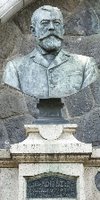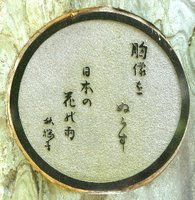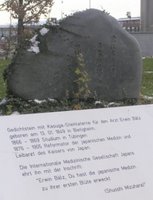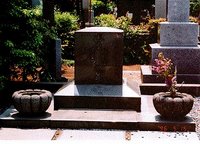:::::::::::::::::::::::::::::::::::::::::::::::::::::::::::::::::::::::::::::::::::::::::::::::::::::
Mizuhara Shūōshi, Shuoshi 水原秋桜子 Shuuooshi Shuoshi
胸像をぬらす日本の花の雨

Japanese rain
on the cherry blossoms
moistens his statue

二人ともに日本人と結婚したが,ベルツの妻の名は「花」という.
The name of the wife of Bälz was also HANA.
http://www.jsp51.umin.jp/annai4.htm
*****************************
The statue is of Erwin Bälz, Erwin von Bälz, the German doctor who introduced modern Medicine to Japan.
Quote from the Wikipedia
Son of a contractor, Bälz was born in 1849 in Bietigheim-Bissingen. He attended grammar school in Stuttgart and studied medicine at Eberhard Karls University of Tübingen. He graduated at the age of 23. Contacts through a Japanese patient led to his appointment at Tokyo Medical College in 1876, at first with a two-year contract.
In the summer of 1899, he visited the Korean Capital Seoul and Busan and undertook ethnological investigations. From April 22 to July 3, 1903, he was again in Korea and, together with Richard Wunsch, undertook an expedition into the interior of the country.
He stayed on in Japan as a university teacher for more than 30 years and taught more than 800 students in Western medicine. On Bälz' initiative, the vulcanic springs of Kusatsu (200 km away from Tokyo) were transformed into the most successful hot spring resort of Japan. He married a Japanese woman and had two children. In 1905, he returned to Germany. In Stuttgart late in the summer of 1913, Bälz succumbed to heart disease.
Bälz was also an ardent art collector, the majority of the Japanese works collected by him are nowadays on exhibiton in the Linden Museum in Stuttgart. A stone sculpture at Tübingen University reminds of his merits for the Japanese medical science. In 1961, a sister city relationship between Kusatsu and Bietigheim-Bissingen was established.
© Wikipedia
xxxxxxxxxxxxxxxxxxxxxxxxxxxxx
Mizuhara wrote some haiku about Bälz. There is even a memorial stone in the city of Tübingen. Thus Mizuhara and Bälz even helped promote the knowledge of haiku at their time.
Ein Haikustein in Tübingen
Volker Friebel
Mitten im Gewirr des Neuen Klinikums Tübingen, hoch über der Stadt, liegt ein Haikustein für Erwin Bälz. Geboren 1849 in Bietigheim, studierte dieser in Tübingen Medizin. 1876 wurde er als Internist an die medizinische Hochschule in Tokio berufen. Er blieb bis 1905 in Japan und unterrichtete westliche Medizin. Sein Einfluss an der Universität und als Hofarzt der kaiserlichen Familie war groß, er gilt als Begründer der modernen Medizin in Japan. .....

Mit dem Haiku hat Bälz anscheinend nichts zu tun. Aber der Haikudichter Shuoshi Mizuhara (1892-1981) studierte bei Schülern von Bälz Medizin. Mehrere Haiku auf japanischen Gedenksteinen für Erwin Bälz stammen von ihm. Und so hat der „Medizinmann“, wenn auch zunächst ganz unverstanden und lang nach seinem Tode, sogar noch etwas zum Bekanntwerden japanischer Kultur in seinem Heimatland bewirkt.
Die Inschrift des Haikusteins in Tübingen lautet:
Kimi ni yorite / Nihon-Igaku no / Hana hiraku
Wörtliche Übersetzung von Mieko Schroeder:
Durch dich / japanische Medizin / erblüht
source : www.haiku-heute.de, 2005 . Volker Friebel
Another version
Erwin Bälz, Du hast die japanische Medizin zu ihrer ersten Blüte erweckt.
www.zajfert.de/co_buch.pdf
Japanese Medicine
started to flower because
of you
(Tr. Dr. med. Gabi Greve)
*****************************
花の雨竹にけぶれば真青なり
hana no ame take ni kebureba masao nari
rain on the cherry blossoms
with bamboo in the mist -
so pale and green
Tr. Gabi Greve, 2006
::::::::::::::::::::::::::::::::::::::::::
The above haiku is rather difficult to translate.
Here are some thoughts of Robin D. Gill:
According to the Nihon Kokugo Daijiten hana-no-ame is
1) rain that falls during the time the cherries are in bloom,
2) rain that falls on cherry blossoms
3) metaphor (mitate) for a heavy fall of blossoms/petals.
There is no way to know for sure without asking the poet, but if he does not mention seeing blossoms, the most common definition = the first = should probably be chosen.
Because of the way the bamboo lets rays of sun into the grove (they are spacy in Japan because people eat the shoots and most landowners clean out the dead ones) one sees mist very well. I favor smokey blue for the cherry rain would come before the new bamboo climbed up and shedding its wrappers revealed its bright new green --- but smoky green or blue, the color of the mist would mentally be a fine match for the pink-white cherry petals even if they were only in the mind’s eye (or there could be some on the floor of the woods for the petals blow through the grove in cherry time).
... ... ... ... ...
Here are some thoughts of Lewis Cook:
I'd say that the verb "keburu" is not to be taken nearly literally. This verb can mean "smoke rises (etc.)", literally, but in poetic usage more often means, metaphorically, "to appear as though seen through mist," or (the most likely sense here) "to appear faintly (vaguely) and [thus] beautifully" (the last is a translation of the entry from a reliable Japanese dictionary of classical Jpn which reads "honori to ustukushiku mieru").
With this in mind, the poem would mean that the rain falling on (or perhaps through, or just as well at the time of the blooming of) the cherry blossoms (hana no ame) seen through a stand of bamboo, is tinted by the color of the bamboo. Bamboo is green of course but diffused by the white of the cherry blossoms the rain may well appear pale blue. "Masao" usually means pale tending towards blue.
Not to complexify matters, but what I think makes this poem effective, now that you confront me with it, is that it defies easy translation (explication). Much of how it does this is by playing on the ambiguity of "keburu" and of "masao". Take two such words and play them off against each other in one verse and there is no end to the repercussions.
Thanks to both for their thoughts. Gabi Greve
*****************************
Another word for GREEN is gunjo 群青 ぐんじょ
taki ochite gunjo-sekai todoro keri
The water plunges -
a sea-green world
thundering
Mizuhara Shuoshi
http://www.ecf.or.jp/shiki/2000/workshop-sum-e.html
:::::::::::::::::::::::::::::::::::::::::::::::::::::::::::::::::::::::::::::::::::::::::::::::::::::
水原秋桜子
みずはら しゅうおうし
1892年10月9日(明治25年) - 1981年7月17日(昭和56年)
医学博士
本名は水原豊(みずはら ゆたか)Mizuhara Yutaka
Japanese LINK with more of his memorial stones
http://www.01.246.ne.jp/~yo-fuse/bungaku/shuuousi/shuuousi.html
His Grave at Somei Cemetery
染井霊園

Read more of his haiku in Japanese
http://www.asahi-net.or.jp/~PB5H-OOTK/pages/M/mizuharasyuosi.html
:::::::::::::::::::::::::::::::::::::::::::::::::::::::::::::::::::::::::::::::::::::::::::::::::::::
Quote
© Susumu Takiguchi, The Daily Yomiuri
Today, we shall look at a giant in the history of Japanese haiku, who initially followed the Hototogisu School as a prominent student of Kyoshi Takahama but later initiated a spectacular rebellion against him.
Shuoshi Mizuhara (1892-1981)
naku hibari/matsukaze tachite/ochi ni kemu
singing skylark...
against the wind blowing through pines,
has descended
Every bit of this haiku reflects neoclassicism. It also reflects the old poetic tradition of Japan. From the time he was a middle school student, Shuoshi had a passion for tanka verse. His introduction to haiku came relatively late at the age of 27. However, once he started, his progress was remarkable. Soon he approached the Hototogisu School, and his success was such that he was accepted as a disciple of Kyoshi within a few years. He also revived the Todai Haiku-kai (Haiku Society of Tokyo University) with Fusei Tomiyasu, Mizuho Nakata and Seison Yamaguchi. His prospect as a haijin, it seemed, was bright.
moya no naka/asa-mo karu fune/mie-some nu
from the mist
a boat for cutting reeds in the morning
has begun to emerge
The subject, terminology and sentiment displayed here are those of waka verse. So much so that I am tempted to suspect if Shuoshi really knew the difference between haiku and tanka. If someone says that this haiku is like a truncated tanka, I would not strongly disagree. If we add something like "My sleeve gets wet with my tears as I think of my lost love," it would become a perfect waka. His deep knowledge of classic Japanese literature and his study of tanka under the famous tanka poet Utsubo Kubota had too strong an influence on his haiku-writing. This was to compel him to walk a different path from that of Kyoshi, but it also gave his haiku depth and richness.
yoi-yami ya/kayoi nare-taru/imo-batake
twilight...
the sweet potato field that is
my shortcut
This is to me one of his most haikulike pieces. First and foremost, the language is that of haiku. The subject, the sweet potato field, is a haikulike thing, ordinary, unpretentious and humorous. Using it as a shortcut all the time and therefore being able to walk home at dusk without going astray or tripping over or falling is a haikulike topic and displays a good sense of humor. Haiku is not a shortened tanka any more than tanka is not a prolonged haiku.
Let us see if we can find some more of these.
shishimai wa/iri-hi no fuji ni/te o kazasu
lion-dance dancer
shading his eyes with his hand to look
at Mt. Fuji in the sunset
Shishimai is a New Year's custom. A dancer puts on a huge lion's mask and a robe that looks like a lion's body. Everything looks fearsome. The performer dances to hayashi music played by flutes, drums and bells. The idea is that this dancing will frighten evil away and help secure peace at home. Some children start crying when they see the costumed dancer, believing him to be a real fearsome creature.
In this case, the human wearing the costume wishes to view the sacred Mt. Fuji on New Year's Day. Something comic and human is at the center of this haiku as well as the general atmosphere of celebration and freshness of this special day.
uragare ya/take-zao aoki/hane-tsurube
withered scene...
the bamboo pole is green;
a well bucket
The trees, bushes and grass are all withered because it is winter. Among these dull colors, only the bamboo pole used for supporting the well bucket has a vivid green color. Such a contrast is a technique of haiku and here it is superbly executed. There is no sentimentality brought in here. That would be tanka. Haiku is drier and more detached.
chugen no/itsumo no e naru/uchiwa kana
summer seasonal gift...
once again the same fan with
the same motif
Japan is a paradise of present giving. It seems the Japanese are giving presents almost constantly. However, there is also some specific seasonal present giving, and chugen is the name for the presents given in summer. The author receives a present, but it is not only the same gift as last summer, but also the same design into the bargain.
nemutasa no/unaji otonashi/tenkafun
sleepy...
the neck of the child not moving,
talcum powder
Such is the heat of the Japanese summer that children often suffer from heat rashes. Adults do too. To see white talcum powder on the skin of babies and children is therefore very seasonal.
natsuboo no/hi o terikaesu/nagisa kana
summer hats...
reflecting the sun,
seashore
Summer hats are normally white in color, at least pale colors, in order to reflect the sun. They look as if they are shining and broadcasting bright light. This is a brilliant depiction of the hot summer.
saku yorimo/otsuru tsubaki to/nari-ni keri
camellia flowers...
now, more of them are falling
than blossoming
When camellias start blossoming all the flowers are in the tree. However, very soon we are surprised by the enormous amount of fallen camellia flowers on the ground. This causes in our heart some kind of a feeling--melancholy, sadness or resignation.
* * *
Kyoshi emphasized the importance of objective sketches from life.
Shuoshi, on the other hand, insisted on the importance of subjective thoughts. This is the greatest point of departure between these two talented poets. Soon, Kyoshi showed his displeasure by publicly rebuking Shuoshi or praising other disciples who pursued Kyoshi's way, especially Sojo Hino, or both.
It is, however, strange for me to look at the haiku by Shuoshi and find most of them not subjective but objective. Maybe this subjective/objective controversy is a relative one, and in the days of Kyoshi and Shuoshi the differences may perhaps have been subtle. Today, we see haiku with blatant and obscene subjectivity. Compared with them, Shuoshi's haiku poems look elegant and objective.
A good example is this haiku that we first looked at last September:
fuyu giku no/matou wa onoga/hikari nomi
winter chrysanthemums...
all they are wearing is
the light of themselves
In Western haiku, this work would most definitely be criticized because it uses what is called anthropomorphosis, or personification. They would say, "Chrysanthemums don't WEAR, only humans do." The Japanese word "matou" is even heavier and used for such things as one's best dress, or an overcoat. So, it might have sounded to Kyoshi that the chrysanthemums are "showing off" and that it is Shuoshi who imposes his will on them, which has nothing to do with them.
Talking about one's own light also sounds like boasting and celebrating one's own ego, similar to liking one's own voice or laughing at one's own joke. However, to me the haiku is pure adoration of these wonderful flowers in an original and beautiful way and, most importantly, in a way that emphasizes how human interference, let alone some busybody's irksome subjectivity, is totally absent.
anegawa to/kiku ni/mushi no ne/tada narazu
River Anegawa...
just hearing this name would make
the crickets call out in alarm
This haiku is slightly pedantic and also subjective. Like Hastings or Gettysburg, Anegawa is an old battlefield where Oda Nobunaga beat the coalition of Asai Nagamasa and Asakura Yoshikage in 1570. Most Japanese know it, but to allude to it in a haiku in such a blatant way as this could be offensive, or at least irritating, to some antielitist and anti-intellectual poets.
(Jul. 27, 2006)
:::::::::::::::::::::::::::::::::::::::::::::::::::::::::::::::::::::::::::::::::::::::::::::::::::::
天騒ぎ摩利支天岳に雷おこる
ten sawagi Marishiten-gake ni rai okoru
heaven is in uproar -
at Mount Marishiten
there is thunder
. Marishitengake, a mountain in Kiso
and Marishiten, God of the Warriors
.................................................................................
waka-kaede kage sasu suzuri araikeri
. Inkstone (suzuri 硯) .
:::::::::::::::::::::::::::::::::::::::::::::::::::::::::::::::::::::::::::::::::::::::::::::::::::::
:::::::::::::::::::::::::::::::::::::::::::::::::::::::::::::::::::::::::::::::::::::::::::::::::::::
Mizuhara Haruo (Shunroo) 水原春郎
(みずはらはるお)
born 1922, son of Mizuhara Shuoshi 水原秋桜子
. night in early summer -
Chekhov is also
a doctor
.......................................................................
刺青の牡丹のさわぐ夏祭
irezumi no botan no sawagu natsu matsuri
at the summer festival
the peony tatoo
is so excited

source : www.dclog.jp/en
. irezumi 刺青 tatoo .
*****************************
Related words
***** World Kigo Database : GREEN in Haiku
***** WKD : Cold rain on the Cherry Blossoms (hana no ame)
:::::::::::::::::::::::::::::::::::::::::::::::::::::::::::::::::::::::::::::::::::::::::::::::::::::
Introducing Japanese Haiku Poets
:::::::::::::::::::::::::::::::::::::::::::::::::::::::::::::::::::::::::::::::::::::::::::::::::::::
[ . BACK to DARUMA MUSEUM TOP . ]
[ . BACK to WORLDKIGO . TOP . ]
:::::::::::::::::::::::::::::::::::::::::::::::::::::::::::::::::::::::::::::::::::::::::::::::::::::
kisutsuki ya ochiba o isogu maki no kigi
ReplyDeletewoodpecker ——
leaves quickly fall
in the meadow
Woodpecker, a KIGO !
朝市に磯もの多し神無月
ReplyDeleteasaichi ni isomono ooshi kannazuki
at the morning market
there is a lot of seafood -
month without the gods
Mizuhara Shūōshi 水原秋桜子
(Tr. Gabi Greve)
kago kabau hoozuki-ichi no yoi no ame
ReplyDeleteCovering up the baskets!
evening downpoor at the
Hozuki-Market
Lampion flower market
ひぐらしやここにいませし茶の聖
ReplyDeletehigurashi ya koko no imaseshi cha no hijiri
Higurashi cicadas -
here he is still alive
the Saint of Tea
MORE about Eisai, the Saint of Tea
http://edoflourishing.blogspot.jp/2013/02/hijiri-holy-men.html
冬杉に月照り武蔵一の宮
ReplyDeletefuyu sugi ni tsuki akari Musashi Ichi no Miya
pines in winter and
moonlight on Musashi
Ichi no Miya shrine
Musashi Ichi no Miya 武蔵一の宮 - Hikawa Jinja 氷川神社
蟇ないて唐招提寺春いづこ
ReplyDeletehiki naite Tooshoodaiji haru izuko
a toad calls -
at temple Toshodai-Ji
where has spring gone ?
The toad comes out in early spring to lay eggs, and goes back to hibernation.
Then in late spring toward early summer, it comes out again.
MORE
about the temple
.
十六夜やふるき坂照る駿河台
ReplyDeleteizayoi ya furuki ita teru surugadai
moon on the sixteenth night -
the old boards shine
at Surugadai
more about Surugadai
http://edoflourishing.blogspot.jp/2015/10/surugadai.html
.
猿飴の湯島の宮の七五三
ReplyDeletesaruame no Yushima no Miya no shichi go san
the Shichi-Go-San festival
at Yushima Shrine
with Monkey Sweets
.
The Yushima district in Edo
https://edoflourishing.blogspot.jp/2015/10/yushima-district.html
.